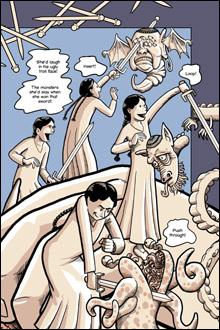
EMBEDDED: In creating his heroine, Deutsch was inspired by the Hernandez brothers’ Love and Rockets and Stan Sakai’s Usagi Yojimbo. |
Hereville, one of the most charming graphic novels published this year, began when alternative-comics artist Barry Deutsch wondered why traditional heroic fantasy stories never featured Jews. "One reason," he says by email from his home in Portland, Oregon, "was that Jews in Europe in the Middle Ages were forbidden to own swords, which would have made dragon fighting especially difficult. So I began to think about doing a dragon-fighting fantasy, except with a Jewish hero who is breaking the law just by having a sword."
Deutsch had originally intended his protagonist to be a Jewish woman in the Middle Ages. Instead, she became a contemporary American 11-year-old girl, Mirka Herschberg, who fights a troll for a sword so she can become a dragon slayer.
Hereville is not your typical graphic novel, even from the alternative-comics press. Hereville's population consists almost entirely of an Orthodox Jewish community. You might think that Deutsch himself is religious, but that turns out not to be the case: he's an atheist who had a typical American Jewish childhood. "Our family wasn't very observant when I was a kid. I went to Hebrew school, and we observed Passover and the High Holy Days. I also attended a Jewish summer camp, Camp Modin in Maine. But that was about it."
Despite his lack of religious observance, he professes an affinity for Jewish culture, and he wants to see more visible Jewish characters in pop culture. Fifteen years ago, he read Liz Harris's book Holy Days, about Hasidic life in Brooklyn, and it stayed with him. "Setting the story in a fictional Orthodox community lets me research traditional Jewish life, which is enormously fulfilling and also gives Mirka even greater barriers to overcome."
Deutsch's favorite comic stories are those he calls "embedded" in the cultural background of the artist. He cites the Hernandez brothers' Love and Rockets and Stan Sakai's Usagi Yojimbo as two examples. Love and Rockets features Latino characters; Usagi Yojimbo is set in 17th-century Japan. "Usagi in particular was an inspiration to me, because Sakai takes a slam-bang sword-fighting comic and makes it so much better by using such a specific and well-researched setting."
Deutsch himself has done his research: Hereville is a credible rendering of the Orthodox Jewish world. He contrasts Mirka's quest with her regular life of attending a Jewish day school and observing the sabbath with her family. And if the plot comes to a halt during the sabbath, the story does not. Deutsch shows how integral Mirka's background is to her adventure. The simple, vital line art makes for expressive characters as well as rich backgrounds that immerse us in Mirka's world.
It's also important that Mirka is a girl. Some of the best scenes focus on Mirka and her stepmother: Fruma delights in arguing with her stepdaughter so that Mirka will learn to see both sides of every issue. In fact, what with Mirka, Fruma, Mirka's sisters, and the witch who directs Mirka to the sword, there's barely room for male characters. Hereville easily passes the "Bechdel test" for fiction (named for artist Alison Bechdel): its women talk to each other about topics other than men.
Deutsch is working on two sequels to Hereville. That's good news for readers who are looking for something different.